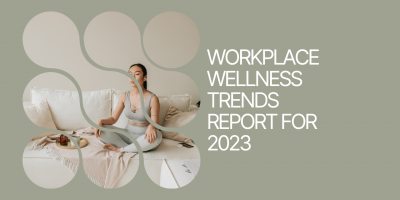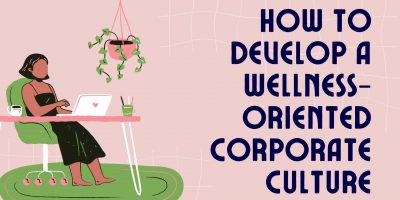
Workplace Wellness Trends Report for 2023
Whether it’s through the use of technology, a focus on mental health, or a greater emphasis on DEI efforts, these workplace wellness trends provide exciting opportunities for businesses.


Co-CEO of Burnalong

CEO of MBX

VP of Biz Dev & Partnerships for Peerfit

Founder & CEO of Compt

CEO of Tripplo

CEO of Saberr

CEO & Founder of Werkling

Marketing Manager of Readiness.org

Human Resource Manager of Tomedes
It‘s no surprise that workplace demands are shifting and the wellness trends with it. Whether it‘s adapting to flexible and hybrid settings, bringing fairness and equality to a diverse workforce, or finding ways to upskill your employees, operating in a state of flux and uncertainty has become the new normal.
With more than 4.4 million Americans quitting the workforce, the “Great Resignation” highlights employees’ financial, mental, and physical burnout due to the pandemic. Greater emphasis on holistic wellness, a new work-life balance, and addressing employee mental health is at the forefront of employers’ priorities.
In collaboration with outstanding CEOs, HR practitioners, and wellness professionals, this report addresses the upcoming corporate wellness industry trends for 2022.
Currently, the workforce is comprised of five different generations:
A one-size-fits-all approach to designing benefit plans will not work without considering employees’ different generational values and career priorities.
Daniel Freedman, Co-CEO of Burnalong, reflects the need for a push for local, authentic, and diverse programming. He expresses that by saying,“The broader societal movements on diversity and inclusion have started to impact wellness programming too, with HR departments realizing you can’t take a one-size-fits-all approach. It needs to reflect the diversity, and diverse needs, of populations.”
This sentiment is also reflected in a response from Dino Ha, CEO of MBX. According to Mr. Ha, “You may want to consider creating a benefits plan that takes into consideration generational diversity. This is when it‘s essential to recognize that team members are at varying stages in life and will want and appreciate different things. Boomers value health insurance and a retirement plan.
In comparison, Gen X prioritize salary level and a 401K plan, while Millennials and Zoomers value paid time off and control over when they work and from where. Embracing generational diversity engages and motivates employees and makes them feel valued, enabling them to work better as a team.”
In the upcoming year, employee benefits will play an elevated role in retaining top talent. In fact, one study found that 66% of employees are waiting to review the new company’s benefits plan before deciding whether to leave the company.
Moving forward, employers that want to avoid the long-term effects of the “Great Resignation” will need to rethink and design their wellness programs in a way that truly aligns with the needs of their employees.

The pandemic has also caused a change in what employees look for in their benefits plans. Office-based perks such as free snacks are becoming obsolete, and employees nowadays appreciate more comprehensive and traditional benefits, such as mental health services and healthcare.
As Emma Maurer, the Vice President of Business Development and Partnerships for Peerfit, outlines, “Wellness trends are continuously evolving and more than ever, there needs to be a focus on the individual employee’s needs and wants.”
Amy Spurling, Founder & CEO of Compt, confirms this sentiment by stating, “Employers need to reframe their mindsets and start thinking about wellness more broadly. They need to figure out how to build sustainable wellness approaches and move away from gym memberships, especially since so many workers are now remote. It’s important to remember that wellness means something different to everyone, and your employees have unique needs.”
However, as incentivization is becoming less successful in encouraging participation in wellness programs, HR practitioners need to shift their focus to customizable wellness solutions. By integrating AI with wellness plans, employees will get a richer and more personalized experience.
Daniel Freedman explains this further, saying,

The drastic shift to remote work in the last two years has forever changed how we define a workplace. During the pandemic, almost 50% of employees in the US were working from home.
Post-pandemic, many organizations are opting to continue remote work to a varying degree, hence the rising popularity of hybrid work models. However, this new era of flexibility comes with its own challenges of adapting a wellness strategy to a new working landscape.
Axel Hernborg, CEO of Tripplo, affirmed the importance of wellness by saying, “Wellness activities must be a part of your culture in 2022, whether your employees are in the office full-time or part-time. Offering activities that may be done either in the workplace or remotely is a trend in employee health that will grow next year.”
The most significant benefits of remote work for employees are flexibility and freedom. Promoting a culture of wellbeing means developing a healthy work-life balance, and a hybrid work model can be considered a “wellness trend” in itself.
On the other hand, screen time for adults is rising. The biggest struggle that remote workers experience is not being able to unplug, followed by difficulties with communication and loneliness. All these factors contribute to employees feeling stressed and struggling to cope with a changing world. For flexible workplaces to be successful, companies in 2022 must prioritize digital wellbeing to mitigate some adverse effects.
Another expert insight provided by Tom Marsden, CEO at Saberr, notes, “The constant U-turn on remote working guidance is leaving employees feeling completely burnt out, and the percentage of people quitting their jobs is at the highest rate in a decade – not what you’d expect during a pandemic.
One of the reasons for this comes down to basic team operating processes. We’re specifically seeing many organizations cling to office-based meeting practices in a remote or hybrid environment. “Zoom fatigue” is an oversimplification of the problem. ”
He adds, “A big part of the problem is the over-reliance on ‘a quick chat’ as the default method of solving problems, sharing information, collaborating, or making decisions. This is perhaps why employees are 24% more likely to be emotionally drained by additional meetings.
The trend in 2020/2021 was to get the right infrastructure in place to make remote/hybrid work possible. Tools like Slack, Zoom, and Microsoft Teams. But companies realize that communication tools alone aren’t enough to support this new way of working. Instead, what’s needed are team-based technologies that can help teams build good relationships without needing an office. To adopt new routines, new habits, and processes to remain effective, increase wellness, and avoid burnout in 2022 and beyond.”
The domain of employee wellbeing is experiencing a shift towards a more holistic approach. Nowadays, the benefit plans include all dimensions of wellness – mental, physical, emotional, and financial.
Employee’s mental health suffered greatly during the pandemic, as shown by countless statistics and studies.
Michelle Fotheringham, CEO & Founder of Werkling, points out an interesting outcome as a result of the pandemic, stating, “In 2022, we can expect a move away from performative wellbeing and a more intentional step towards addressing the root causes of burnout and poor mental health in workplaces.
Fruit baskets and free yoga classes are not going to be good enough! Top talent is simply not willing to work for organizations that overwork their people and prevent them from living their best lives. Work design and culture will be at the heart of wellbeing strategies.”
In response to this mental health crisis, employers are looking for different ways to support their employees’ mental health needs. According to a wellness trends survey conducted by Shortlister, all mental and behavioral health offerings saw an increase in interest in 2020.
Health and wellness solutions that focus on resilience training, virtual mental health services, mindfulness apps, and positive coping mechanisms will be essential in 2022 to support a positive culture.

The response from Emma Maurer establishes this sentiment further, as she says, “We’re going to see more corporate wellness programs focused on mental health and mindfulness, as we continue to get through the pandemic and establish a new normal in a hybrid workplace.
In addition, ensuring that employees have a positive work-life balance coupled with competitive benefits. Those employers focused on these factors will not only be able to retain their current workforce but attract new and upcoming talent.”
However, Jill Holmes, Marketing Manager of Readiness.org expressed concern and shared the findings of Readiness‘s research in conjunction with the Swinburne University of Technology. According to the study, “Employees need to be able to access the wellbeing services offered by their employees directly to increase use – HR or managers are still ‘gate-keepers‘ to accessing these services in 61% of cases.“
Holmes added, “The solution must provide employees with direct access to these services without needing to go through HR or their managers. A solution which offers a variety of wellbeing resources is key – such as online learning, peer support, counseling, workshops, and EAP services.“
Research also shows that mental health interventions yield the most significant ROI compared to other initiatives, so it is no surprise that this employee wellness trend will remain on the agenda for 2022.
In the words of Jerica Amores Fernes, the HR Manager of Tomedes Translation Company, who shared their experience, “The shift to remote work has been a stressful experience for employees and has shown the need to address mental health.
Since we at Tomedes have been on this model from the outset, mental health is something we’ve long taken into consideration. For many other companies, I believe that this will be an eye-opening experience, and we may expect to see more support for mental health through company policy and programs in the future.”
DE&I efforts are vital to the health and wellness of all employees, but even more so for underrepresented groups. Inequitable access to healthcare has dramatically affected the wellbeing of these groups. We will see further expansion to improve access to healthcare and corporate wellness of minority workers in the upcoming year.
Furthermore, employee mental health is closely linked to the environment and experiences of inclusion in the workplace. One of the biggest threats to employee wellness is the “Emotional Tax” issue.
Employees pay an Emotional Tax at work whenever they feel they have to be on guard to protect themselves from bias or discrimination. The stress and anxiety of people who have been historically marginalized in the workplace manifest into various health-related issues.
As eliminating unconscious bias is always a top priority, we see organizations take a different approach to resolving this problem. Many HR professionals adopt a decision-making strategy called blind hiring. They are given no personal details of the candidates to reduce bias.
On top of that, more companies are using HR tech for good by implementing responsible AI. In the age of machine learning and automated HR functions, companies rely on ATS systems to safeguard against recruiting bias, dashboards to signal DE&I shortcomings, and bias bounties to audit algorithms and ensure equal opportunities for their workers.
To truly allow a diverse workforce to thrive, we have seen an expansion to the DE&I initiatives to include another dimension – belonging. Employers must address racism, ableism, ageism, and sexism to tackle these issues to achieve a holistic wellbeing solution.
DEI&B places a greater emphasis on eliminating these harmful experiences and fostering a sense of belonging within the organization. As the war for talent continues, one way to attract and retain top talent in 2022 is to display sincere care and commitment to a diversified and inclusive workforce.
In fact, 87% of Millennials say that professional development or career growth opportunities are extremely important. When employees find themselves in a culture of continuous learning, they feel happier, more engaged, and productive.
People analytics helps HR deploy performance management as data-driven and actionable instead of intuition-based. With the help of talent analytics platforms, companies can identify employees whose skills may be a good fit for other positions within the company.

In an agile and ever-changing business landscape, locked-in and predefined career paths are a thing of the past. Finding and retaining top talent is a major challenge in 2021, so HR professionals must consider reskilling employees to create internal mobility.
The rate at which changes are happening in the world of corporate learning is exciting. Reinvention by introducing AI and VR solutions, new tools, cohort-based courses, and digital academies are helping employees continuously upgrade their skills.
Planned skilled development, internal mobility programs, and upskilling employees by providing learning and development (L&D) opportunities are essential to keeping and developing your workforce.
However, people analytics’ potential remains largely untapped despite its growing popularity. A lot of it is due to HR’s data illiteracy, so data analytics is a must-have skill for HR professionals in the upcoming year.
In 2022, rethinking employee development and providing career advancement opportunities will be crucial for improving the occupational dimension of the employee wellness wheel.
The past few years have been filled with job uncertainty and financial stress for many workers.
Inflation in the United States hit a 31-year record high of 6.2% in October 2021. The rising cost of goods, services, and shelter has put an additional strain on workers’ pockets. These events have driven high demand for financial wellness services, as supported by Shortlster’s employee wellness statistics.
Low financial literacy is one area of concern. Still, actual budgeting, saving, and managing debt is vital to the overall financial wellbeing of employees.
One survey asked respondents about their top five wellness priorities, and “reducing current debt” and “not living beyond my means or staying within a budget” were both top three in importance.
This same financial stress can have a far-reaching impact on a company’s wellbeing, including higher costs for healthcare use, loss of productivity due to absenteeism, and lower retirement savings and participation.
Although our society is becoming more digital, studies show that employees desire human interaction and access to unbiased counselors to manage their personal finances. As employees are less trustful of robo-advisors or online tools, the most successful financial wellness programs need to balance technology and human connection.
Improving short and long-term financial wellness and creating sustainable behavior changes are essential to any holistic health and wellness program.
As we look back on a year characterized by disruption, it is hard to predict what changes 2022 will bring. However, one emerging macro trend we notice is the widening scope and role of the human resource department.
The HR department has an increasingly strategic value in a company.
It needs to be accountable for the impact on the broader ecosystem of an organization in society and place genuine human concerns on the table.
Based on the expert’s opinion and market trend analysis, employers can get meaningful insights and better prepare for the year ahead by understanding these corporate wellness industry trends.
Browse our curated list of vendors to find the best solution for your needs.
Subscribe to our newsletter for the latest trends, expert tips, and workplace insights!

Whether it’s through the use of technology, a focus on mental health, or a greater emphasis on DEI efforts, these workplace wellness trends provide exciting opportunities for businesses.

Discover over 30 advantages of implementing corporate wellness programs in your workplace.

If you think a ping-pong table and massage chairs will make employees find long-lasting fulfillment at work, think again.

Discover practical strategies and actionable steps to promote employee well-being and productivity. Create a workplace environment that prioritizes health and fosters a thriving, engaged workforce.
Used by most of the top employee benefits consultants in the US, Shortlister is where you can find, research and select HR and benefits vendors for your clients.
Shortlister helps you reach your ideal prospects. Claim your free account to control your message and receive employer, consultant and health plan leads.